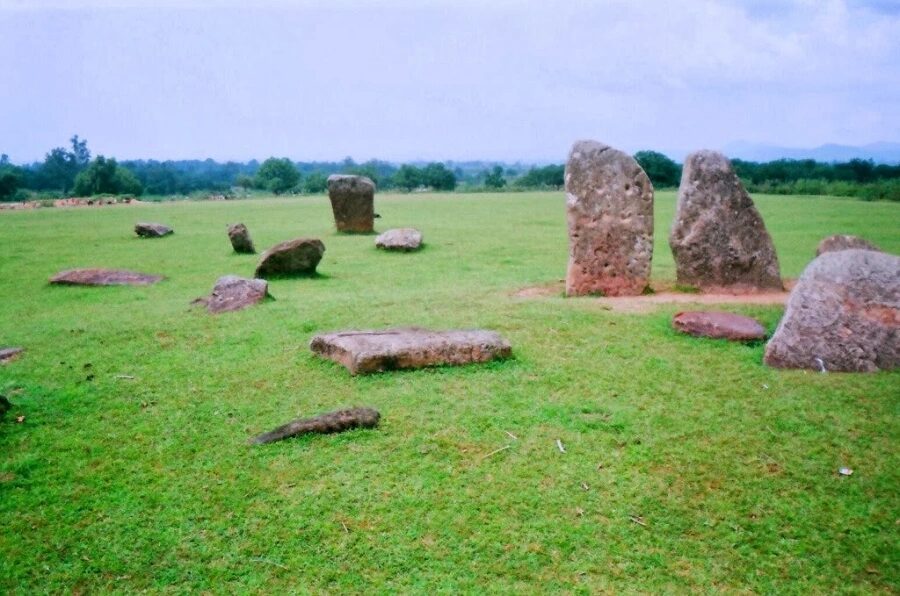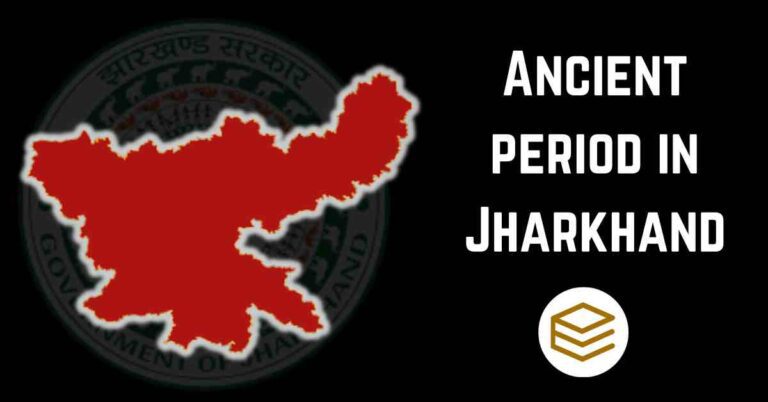December 8, 2025 5:28 pm
Prehistoric Period in Jharkhand
The Prehistoric period in Jharkhand is the era for which there are no written records; knowledge about this period is derived from archaeological sources.
Major Divisions of the Prehistoric Period in Jharkhand
- Paleolithic Period (Old Stone Age)
- Timeline: Approximately 2.5 million years ago to around 10,000 BCE.
- Characteristics:
- People during this period were hunter-gatherers and did not have knowledge of agriculture.
- They used stone tools made from quartzite, although they had no knowledge of advanced tool use.
- Evidence of this period in Jharkhand is found in Hazaribagh, Barwadi, Bokaro, Ranchi, Deoghar, West Singhbhum, and East Singhbhum.
- Mesolithic Period (Middle Stone Age)
- Timeline: Approximately 10,000 BCE to 1,000 BCE.
- Characteristics:
- People began domesticating animals.
- Small stone tools (microliths) have been found from this period.
- Jharkhand sites with evidence from this period include Dumka, Palamu, Dhanbad, Ranchi, West Singhbhum, and East Singhbhum.
- Neolithic Period (New Stone Age)
- Timeline: Approximately 10,000 BCE to 1,000 BCE.
- Characteristics:
- Agriculture and animal husbandry began to be practiced.
- Stone tools became more polished and advanced.
- Evidence of this period in Jharkhand includes tools and pottery fragments from Chotanagpur, where 12-handled pottery items have been found.
- Chalcolithic Period (Copper Age)
- Timeline: Approximately 4,000 BCE to 1,000 BCE.
- Characteristics:
- This period overlaps with the early Indus Valley Civilization.
- Copper tools were developed along with stone tools, marking a significant advancement.

Jharkhand in the Metal Ages
5. Copper Age
- Known as: Copper Age
- Characteristics:
- Humans began using tools and artifacts made from copper.
- This period shows the use of pure copper tools, particularly by tribes like the Asur.
- Copper tools have been found at sites like Singhbhum and Hazaribagh.
- In Hazaribagh, particularly in Bahabar region, copper items like a 49 cm-long copper sword have been discovered.
6. Bronze Age
- Known as: Bronze Age
- Characteristics:
- Bronze, an alloy of copper and tin, started to be used for making tools and artifacts.
- The Asur tribe, known for metalwork, was significant during this period.
- Bronze tools were found in various areas and were used in activities such as hunting and daily tasks.
7. Iron Age
- Known as: Iron Age
- Characteristics:
- Tools made from iron were developed and widely used.
- The Asur and Birjia tribes of Jharkhand were known for their iron-making skills.
- Iron tools and artifacts from this period signify advanced metalworking skills among Jharkhand’s ancient tribes.
- Jharkhand’s iron tools were even exported to neighboring areas and were used till the Mesopotamian period.
- Dhalbhumgarh is one notable site associated with iron production during this period.
Archaeological Sites in Jharkhand
| Location | Archaeological Findings |
|---|---|
| Isko (Hazaribagh) | Rock paintings depicting human and animal figures, constructed by early tribes. |
| Sitagarh Hills (Hazaribagh) | Sixth-century artifacts, ancient Buddhist caves, and images of Buddha carved in stone. |
| Bahabar (Hazaribagh) | Tools and ornaments from the Copper Age, including copper artifacts. |
| Dumri (Hazaribagh) | Rock art depicting hunting scenes and stone carvings. |
| Dumkumia (Hazaribagh) | Hunting scenes, stone carvings, and rock paintings from the prehistoric period. |
| Bhawanathpur (Garhwa) | Tools and carvings, along with prehistoric art depicting tribal life. |
| Location | Archaeological Findings |
|---|---|
| Pandu (Palamu) | Four-legged stone platform (preserved in Patna Museum), mud walls, earthenware pots, and copper tools. |
| Palamu Fort (Latehar) | Statue of Lord Buddha in the “Bhumisparsha Mudra” (earth-touching gesture). |
| Palamu Region | Tools from all three Paleolithic periods. |
| Barwadih (Singhbhum) | Flint tools from the Stone Age, stone tools, polished stones, and pottery fragments. |
| Benisagar (Singhbhum) | Jain statues from the 7th century. |
| Banari (Singhbhum) | Stone slabs, stone tools, terracotta, ring stones, and other artifacts from ancient times. |
| Bahargarh (Singhbhum) | Neolithic tools, black and red pottery, and Stone Age flint tools. |
| Lohardaga | Prehistoric copper bowls and pottery. |
| Nagri (Ranchi) | Copper and iron tools, stone arrowheads, and stone slabs with inscriptions. |
| Murhu | Broken statue of Lord Vishnu (partially damaged) and Buddhist relics. |
| Lupung | Jewelry pieces, copper and bronze ornaments, stone artifacts, and pottery fragments. |
| Rock Art of Chotanagpur Plateau | Contains carvings of animals, hunting scenes, and human figures. These carvings provide insights into the lifestyle of early humans. |
Notes
- The rock art in Jharkhand includes depictions of animals, hunting scenes, and human activities, which provide insights into the prehistoric life of the region.
- These sites and findings highlight Jharkhand’s rich historical and archaeological heritage, showcasing the evolution of human settlement, art, and culture in the area.
These archaeological discoveries across Jharkhand reflect the state’s historical significance, from the Stone Age to medieval times, with influences from Buddhism, Jainism, and early tribal civilizations.
Useful Links>>
JPSC Notes: Access expertly curated notes covering essential topics for both JPSC Prelims and Mains exams.
14th JPSC PT Exam Comprehensive Test Series: Enhance your preparation with a structured test series designed to cover all aspects of the JPSC Preliminary Test syllabus, emphasizing Jharkhand-specific topics and current affairs.
JPSC Notification 2024: Stay informed about the latest updates, including exam dates, eligibility criteria, and vacancy details for the JPSC 2024 examination.
General Introduction to Jharkhand for JPSC Exam: Gain a comprehensive understanding of Jharkhand’s history, geography, economy, and culture, crucial for the JPSC exam.
official Website: https://www.jpsc.gov.in/





